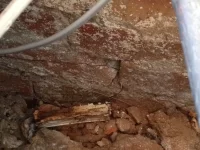Hi all,
I hope it's OK for me to post this on this forum as I'm not a plasterer -- I'm someone who's just moved into a 1905 house that has more than a few damp issues, and I reckon a forum of plastering professionals will be able to identify some of the problems that are worrying me sick.
I've uploaded some photos of moulds or rots that I've found under carpets and lino that I took up at the weekend. The floors in question were really, really damp and I've had windows open and heating on over the last couple of days to start the drying process out. But can you help me tell what I'm dealing with, and how best to get rid in each case?
Thanks so much in advance,
Jodi.
I hope it's OK for me to post this on this forum as I'm not a plasterer -- I'm someone who's just moved into a 1905 house that has more than a few damp issues, and I reckon a forum of plastering professionals will be able to identify some of the problems that are worrying me sick.
I've uploaded some photos of moulds or rots that I've found under carpets and lino that I took up at the weekend. The floors in question were really, really damp and I've had windows open and heating on over the last couple of days to start the drying process out. But can you help me tell what I'm dealing with, and how best to get rid in each case?
Thanks so much in advance,
Jodi.
Attachments
-
 Floor tile 1.webp276 KB · Views: 300
Floor tile 1.webp276 KB · Views: 300 -
 Floor tile 2.webp327.5 KB · Views: 282
Floor tile 2.webp327.5 KB · Views: 282 -
 Floor tile 3.webp179.4 KB · Views: 283
Floor tile 3.webp179.4 KB · Views: 283 -
 Floor tile 4.webp359.3 KB · Views: 278
Floor tile 4.webp359.3 KB · Views: 278 -
 Living Room 1 on plywood.webp226.9 KB · Views: 314
Living Room 1 on plywood.webp226.9 KB · Views: 314 -
 Living Room 2 on floorboards.webp235.8 KB · Views: 276
Living Room 2 on floorboards.webp235.8 KB · Views: 276 -
 Living Room 3 on floorboards.webp281.3 KB · Views: 280
Living Room 3 on floorboards.webp281.3 KB · Views: 280 -
 Living Room 5 on floorboards.webp246.5 KB · Views: 277
Living Room 5 on floorboards.webp246.5 KB · Views: 277 -
 Living Room 6 under floor.webp208.2 KB · Views: 281
Living Room 6 under floor.webp208.2 KB · Views: 281 -
 Wall tiles 1.webp181.4 KB · Views: 312
Wall tiles 1.webp181.4 KB · Views: 312
